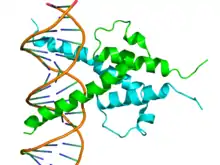| Pho4 | |||||||
|---|---|---|---|---|---|---|---|
 Crystallographic structure of yeast Pho4 homodimer (cyan and green) complexed with DNA (brown).[1] | |||||||
| Identifiers | |||||||
| Symbol | Pho4 | ||||||
| Alt. symbols | YFR034C | ||||||
| NCBI gene | 850594 | ||||||
| PDB | 1a0a | ||||||
| RefSeq | NP_116692 | ||||||
| UniProt | P07270 | ||||||
| |||||||
Pho4 is a protein with a basic helix-loop-helix (bHLH) transcription factor. It is found in S. cerevisiae and other yeasts.[2] It functions as a transcription factor to regulate phosphate responsive genes located in yeast cells.[3] The Pho4 protein homodimer is able to do this by binding to DNA sequences containing the bHLH binding site 5'-CACGTG-3'.[4] This sequence is found in the promoters of genes up-regulated in response to phosphate availability such as the PHO5 gene.[5]
Structure
Helical regions are represented by ribbons; non-regular secondary structure elements by thin tubes. Molecules A and B are colored cyan and lime-green, respectively. Helical structure is clearly seen in the loop region.[3] The PHO4 protein consists of 312 amino acid residues (Yoshida et al., 1989) and has four functional domains.[6] PHO4 is one of the regulatory proteins indispensable for transcription of the PHO5, PHO81 and PHO84 genes.[6] The DNA-binding domain of PHO4 consists of two helices, designated H1 and H2, separated by a long loop that contains a novel α-helical region. PHO4 binds to DNA as a homodimer and the two monomers fold into a parallel, left-handed four-helix bundle.[6] PHO4 protein lacks an inner hydrogen network.[6]
Mechanism
Pho4 is a transcription factor that assists in regulating cell growth.[7] When activated, Pho4 is translocated to the nucleus. Pho4 has a Nuclear Exchange factor that an importin protein is able to bind to. The importin protein will bind to its "signal" or nuclear exchange factor and aid in translocating the nuclear exchange factor tagged protein into the nucleus. Additionally, another transcription factor known as Pho2, binds to Pho4 and assists in Pho4's ability to bind tightly to its binding site on its specific target genes.[7] This completes the addition of the binding partners that Pho4 needs in order to be capable of acting as a transcription factor by up-regulating the transcription of phosphate-responsive genes.
Regulation
Suppression
Down regulation of the transcription factor Pho4 is seen when the yeast cell has a phosphate rich environment. Under high phosphate concentrations, it is seen that a cyclin-dependent kinase, known as PHO80-PHO50, phosphorylates PHO4 on its serine residues (O’Neil et al. 209–212).[8] This blocks the binding sites for the importin and Pho2 transcription factor and allows for the receptor Msn5p to assist in the removal of the Pho4 protein from the nucleus and back into the cytoplasmic space.[9] Additionally, because the binding site of importin on the Pho4 protein is blocked from the phosphorylation that PHO4 undergoes, PHO4 is no longer able to be translocated into the nucleus.
Up-regulation
Up-regulation of Pho4 is seen in phosphate deficient yeast cells. This occurs due to cyclin dependent kinase PHO80-PHO85 being inhibited by the cyclin dependent inhibitor PHO81.[8] In low concentrations of phosphate the CDK inhibitor PHO80-PHO85 is able to inhibit PHO80-PHO85 from phosphorylating PHO4 at its serine residues.[8] When this occurs, importin and PHO2 are able to bind to PHO4 and assist in the translocation and tight binding to its binding site on the gene PHO5 which will then become up-regulated.[8]
References
- ↑ PDB: 1a0a; Shimizu T, Toumoto A, Ihara K, Shimizu M, Kyogoku Y, Ogawa N, et al. (August 1997). "Crystal structure of PHO4 bHLH domain-DNA complex: flanking base recognition". The EMBO Journal. 16 (15): 4689–97. doi:10.1093/emboj/16.15.4689. PMC 1170095. PMID 9303313.
- ↑ Berben G, Legrain M, Gilliquet V, Hilger F (1990). "The yeast regulatory gene PHO4 encodes a helix-loop-helix motif". Yeast. 6 (5): 451–4. doi:10.1002/yea.320060510. PMID 2220078. S2CID 40974115.
- 1 2 Shimizu T, Toumoto A, Ihara K, Shimizu M, Kyogoku Y, Ogawa N, et al. (August 1997). "Crystal structure of PHO4 bHLH domain-DNA complex: flanking base recognition". The EMBO Journal. 16 (15): 4689–97. doi:10.1093/emboj/16.15.4689. PMC 1170095. PMID 9303313.
- ↑ Shao D, Creasy CL, Bergman LW (February 1998). "A cysteine residue in helixII of the bHLH domain is essential for homodimerization of the yeast transcription factor Pho4p". Nucleic Acids Research. 26 (3): 710–4. doi:10.1093/nar/26.3.710. PMC 147311. PMID 9443961.
- ↑ Ogawa N, Oshima Y (May 1990). "Functional domains of a positive regulatory protein, PHO4, for transcriptional control of the phosphatase regulon in Saccharomyces cerevisiae". Molecular and Cellular Biology. 10 (5): 2224–36. doi:10.1128/mcb.10.5.2224. PMC 360570. PMID 2183025.
- 1 2 3 4 Ogawa N, Oshima Y (May 1990). "Functional domains of a positive regulatory protein, PHO4, for transcriptional control of the phosphatase regulon in Saccharomyces cerevisiae". Molecular and Cellular Biology. 10 (5): 2224–36. doi:10.1128/mcb.10.5.2224. PMC 360570. PMID 2183025.
- 1 2 Lim W, Mayer P (2015). Cell Signaling: Principles and Mechanisms. New York, New york: Garland Science. pp. 119–120.
- 1 2 3 4 O'Neill EM, Kaffman A, Jolly ER, O'Shea EK (January 1996). "Regulation of PHO4 nuclear localization by the PHO80-PHO85 cyclin-CDK complex". Science. 271 (5246): 209–12. Bibcode:1996Sci...271..209O. doi:10.1126/science.271.5246.209. PMID 8539622. S2CID 46507331.
- ↑ "PHO4 | SGD". www.yeastgenome.org. Retrieved 2021-05-10.
External links
- PHO4+protein,+S+cerevisiae at the U.S. National Library of Medicine Medical Subject Headings (MeSH)